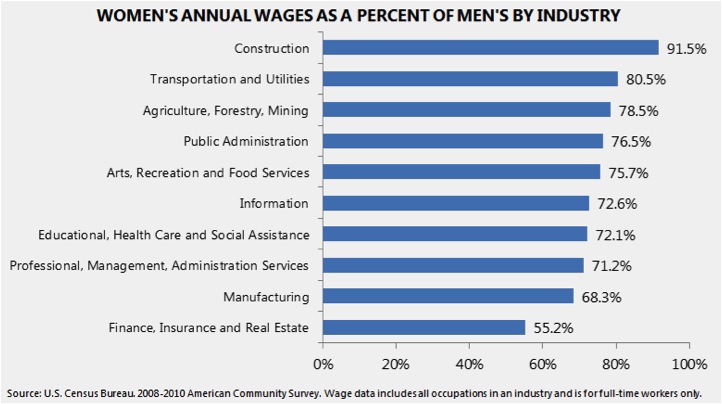EQUAL PAY DAY 2012: A Closer Look at the Wage and Mississippi Industries
April 26th, 2012
In recognition of Equal Pay Day on April 17th, a previous post reviewed wage gaps between men and women across Southern states. This post takes a look at working men and women with an eye towards Mississippi’s industries.
WOMEN, MEN AND MISSISSSIPPI’S INDUSTRIES
While men and women are increasingly equally represented in the workforce, they are not equally represented across all industries. Survey data reveals men represent 90% of Mississippi’s workers in construction and agriculture jobs and close to 80% of those in transportation and warehousing. In contrast, women make up about 80% of the workers in education and health services industries.
The chart shows women’s wages as a percentage of men’s wages for Mississippi’s full-time workers. It is important to note that each industry contains employees in many different occupations, and the wage data presented incorporate positions from management to entry-level workers. However, the graphic illustrates that the pay gap between men and women exists in each of Mississippi’s industries.
It is well established that women are more likely to pursue careers in fields associated with lower earnings. The three industries with the smallest pay gaps –construction, transportation and agriculture- are also traditionally male-dominated industries with a lower portion of women employed. Efforts are growing across the country to connect women to training in higher paying, ‘non-traditional’ careers as one path for lessening the difference in men’s and women’s wages.
Outside of industries, the American Association of University Women finds that even after controlling for factors like education, work position, age, college major, and the number of children in a family, an unexplained, though smaller, pay gap continues to exist between men and women. There is also evidence that this unexplained pay gap may grow over a woman’s career.
The pay gap between men and women has clear effects on families’ income and their economic security. And while the gap has diminished over time, the data from 2010 underscore that steps to preserve work supports for women and their families and steps to reduce gender pay discrimination continue to be necessary for Mississippi’s women and their families.
Author: Sarah Welker, Policy AnalystSources: U.S. Census Bureau. American Community Survey 2008-2010 Averages.






